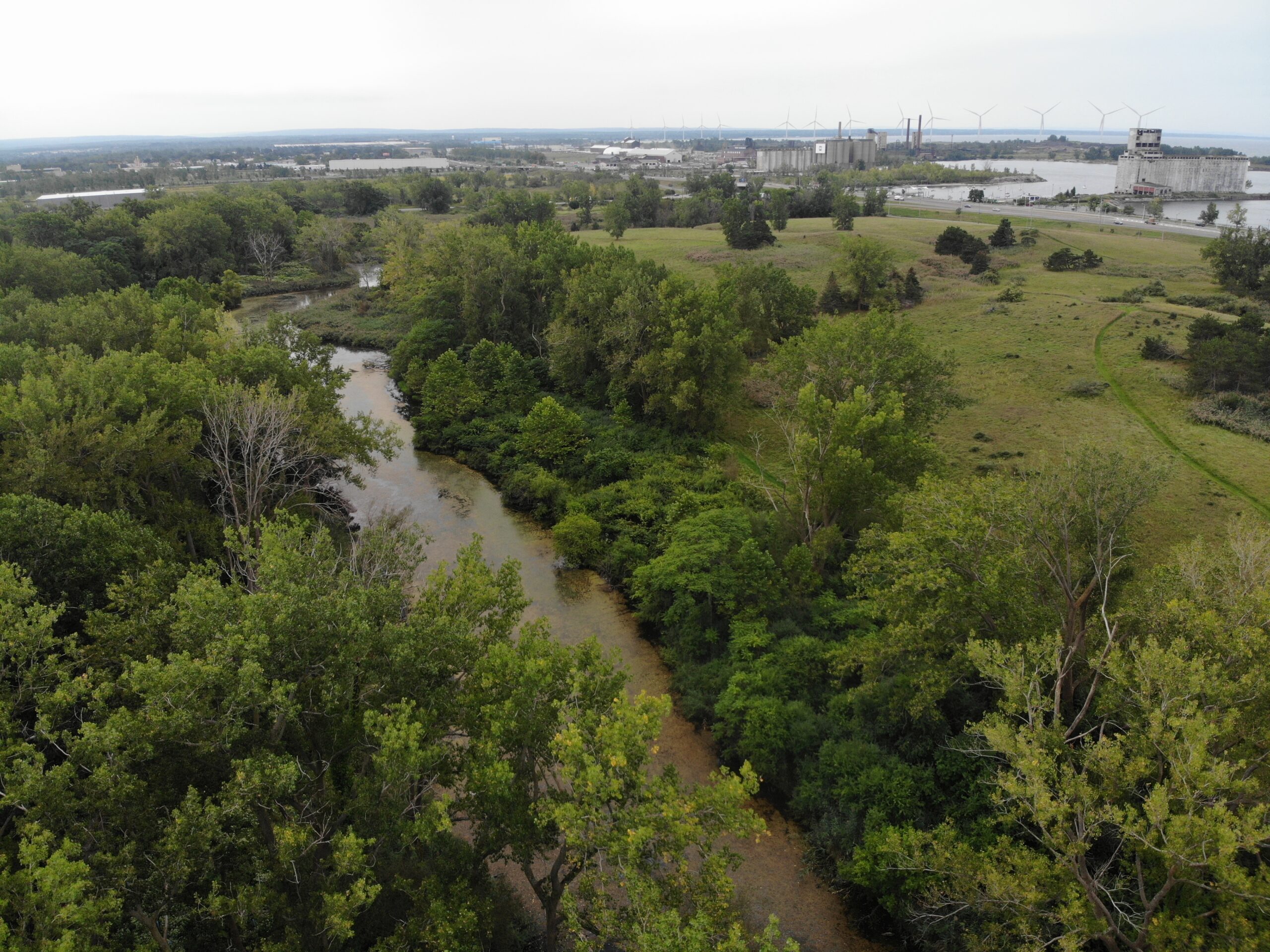EDUCATION CENTER HOURS:
- Home
- Ecological Management
- East Canal Ecological Renovation
East Canal Ecological Renovation
Lake Kirsty is formerly part of a 19th century transshipment facility which served as a transfer point for ore, coal, and lumber between Great Lakes freighters and the Lehigh Valley Railroad. The East Canal is an inlet to Lake Kirsty and part of the original canal system, used specifically for iron ore shipments. In the 1950s and 60s, the canal was used to dispose of slag and municipal refuse, giving it its present-day irregular shape. Visitors regularly walk across the bridge which spans the north end of the canal, to access most of Tifft’s trail system.
The mouth of this canal has been dammed and maintained by beavers for at least 20 years, insulating it from sudden seiche-driven water level rises and wave energy which has hindered the success and establishment of emergent aquatic plants in Lake Kirsty. Much of the canal’s depth falls within the range of suitability for aquatic plants with a maximum depth of about 10 feet and large areas under 2 feet. It is also sheltered to the west from prevailing winds by four hills, an engineered landfill capped in 1975 known as The Mounds. Except for invasive Eurasian Watermilfoil, the canal is lacking in aquatic vegetation, especially emergent vegetation. It is missing an upland-aquatic transition zone. The landscape around the canal is also dominated by exotic invasive plant species, including common buckthorn, autumn olive, bush honeysuckle, tree-of-heaven, Phragmites, and Bohemian knotweed.
From late 2023 though 2026, 63 acres of riparian and aquatic habitat in and around the East Canal will be renovated through intensive management of invasive plants, and thoughtful, comprehensive revegetation efforts. This project is complementary to previously completed work at Tifft Nature Preserve, including the recently completed Mosquito Junction Swamp Restoration project, which is directly east of this project site.
Work done around the East Canal will:
- leverage and protect the ecological outcomes of earlier projects by improving plant community structure and species diversity, and by preventing reinvasion of exotic-invasive plants;
- improve water quality by increasing dissolved oxygen and reducing nutrient input in the canal;
- create an emergent aquatic vegetation zone and ecotone along the canal shoreline providing habitat for state-listed species, including the least bittern and pied-billed grebe;
- improve the canal’s riparian buffer through invasive species removal and native plant community restoration;
- and will aid in the replacement of the existing riparian tree canopy, which is slowly being lost, with a new and more diverse cohort of trees.
The East Canal is a shallow and sheltered waterbody with exciting potential to create and improve habitat for fish, waterfowl, salamanders, marsh birds and songbirds, through the establishment of native aquatic, transitional, and riparian plant communities.
Phases of East Canal Renovation
Phase 1 – Riparian Woodland Renovation
Funded by the Niagara River Greenway Ecological Standing Committee
Woody invasive species, including common buckthorn, glossy buckthorn, bush honeysuckle, multiflora rose, cut-leaf raspberry, autumn olive, and tree-of-heaven, will be removed from about 20 acres immediately around the canal, and from The Mounds as well, where it exists in patches and groundcover. Using mechanized equipment and follow-up herbicide treatments, these species will be reduced to a groundcover of less than 15% of the original extent. A patchwork of Phragmites and bohemian knotweed will be removed across the 63 acre site using wiper and foliar herbicide treatments; and will be reduced to a cover of less than 5% of their original extent. Other invasive plant species, including black swallow-wart, field thistle, mullein, burdock, and teasel, will be managed through an Integrated Pest Management protocol to allow for establishment of native plant communities as intended.
Invasive species removal will be conducted by staff and volunteers, with crew support and guidance from the Western New York Partnership for Invasive Species Management (WNY PRISM).
Areas formerly dominated by exotic invasive species will be revegetated as part of Phase 1. Local reference communities and successes of earlier projects at Tifft will be used to refine the plant communities and species composition. Following initial clearing and treatment work, much of the acreage will be prepared with a power rake and broadcast seeded during the winter of 2024-2025. Wetter soils will be broadcast seeded and hand-raked. A follow-up overseeding will be made during the following winter. Trees and shrubs will be planted at a density of 280 per acre where invasive species have been removed and will be protected from herbivory by wire cages or plastic tubes, maintaining a survival rate of at least 75% for the project duration.
Phase 2 – Shoreline and aquatic plant community renovation
Eurasian watermilfoil will be treated with an herbicide. Bank stabilization and planting along much of the length of the canal will be accomplished through installation of 20” x 10ft coir logs and plants installed in and around each log. Emergent aquatic plants will be installed in depths up to 1 foot, while submerged and floating plant species will be installed in depths up to 3 feet. Live stakes (branches cut and prepared from select shrub species) will be installed in steeper shoreline gradients where coir logs are not feasible.
A temporary deer exclusion fence will be installed for vegetation establishment around about 10 acres surrounding the canal, using Snakeroot Trail, Mounds Bypass, Old Tifft St, and the East Canal bridge as boundaries, avoiding disruption to trail users. A fish and waterfowl herbivory protection fence and grid will be installed around the shore to promote aquatic and transitional vegetation establishment. Breaks will be left in these fences to allow passage of beaver in and out of the canal.


